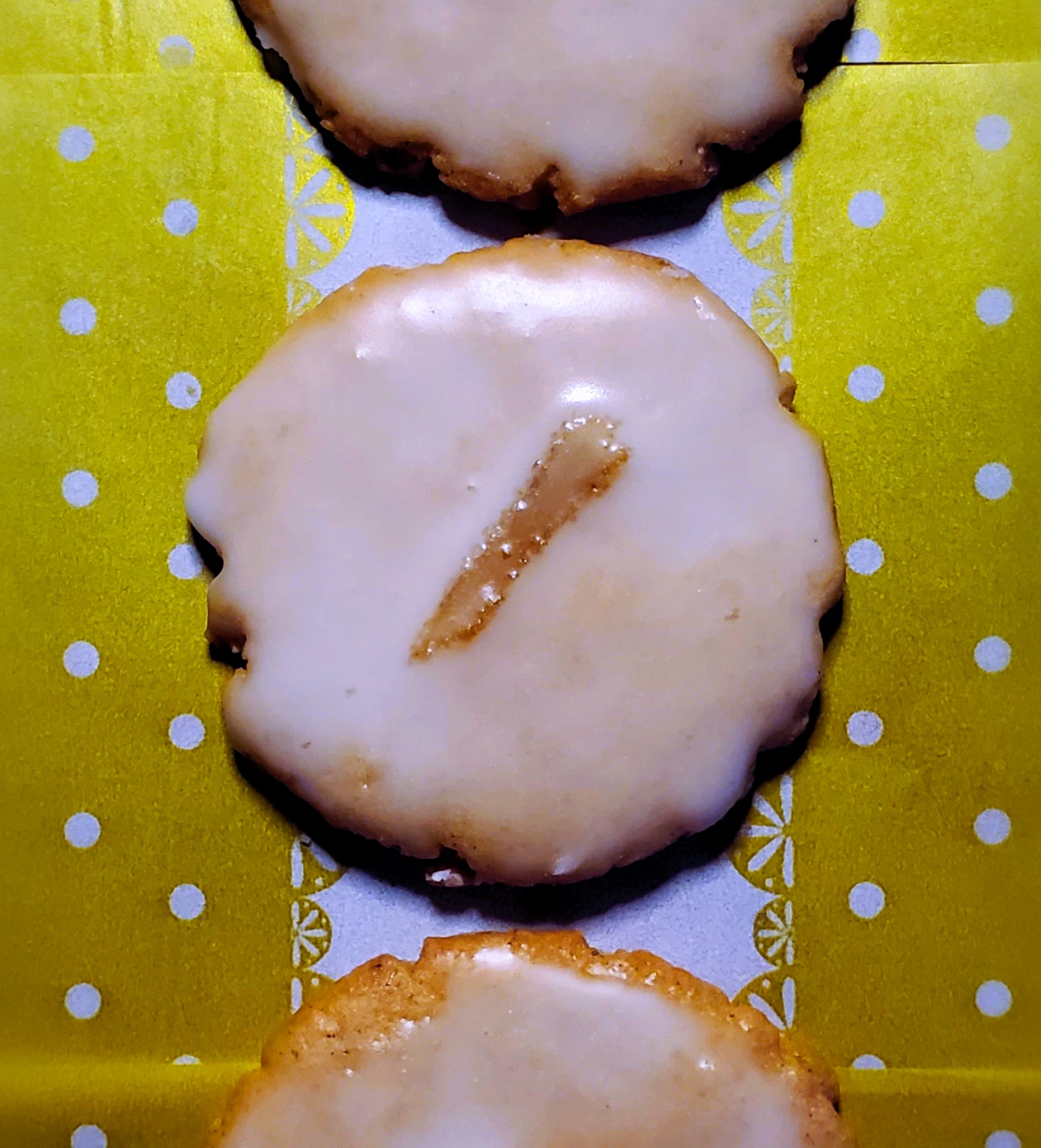
Lemon Glazed Gingersnaps
On November 21, 2024 by Christy LarsenCladia Fleming’s recipe with a little update by me
My first edition of “The Last Course” by Claudia Fleming is well-used and slightly abused. The pages are spattered and worn, and the entire book looks older than its 20 years. It is a great book; if you can find it, I suggest you grab a copy.
These little cookies are delicious, just as Claudia imagined them. As one does, I am giving them a holiday gild. The glaze gives them a few extra days of “freshness” and a distinct citrus punch. Drop them onto your holiday cookie platter, gift them with your favorite tea blend, or drop a few in your glove box for any cookie-related emergency.
Gingersnaps
1 3/4 cups firmly packed dark brown sugar
1 1/2 cups unsalted butter-softened
1 large egg
1 Tbs grated (peeled) fresh ginger
1 1/2 tsp lemon zest
3 3/4 cups all-purpose flour
2 Tbs ground ginger
1 Tbs ground cinnamon
1 1/4 tsp baking powder
1/2 tsp ground white pepper
1/4 tsp ground cloves
1/2 tsp kosher salt
Beat sugar and butter until smooth. Add egg, fresh ginger, and lemon zest and beat well. In a bowl, whisk together flour, ground ginger, cinnamon, baking powder, white pepper, cloves, and salt. Beat until well combined. Form into a large disk, wrap in plastic wrap, and chill for at least 4 hours or overnight.
Preheat oven to 350F. Scoop out 1 tsp of dough at a time and roll between palms. Flatten with the base of drinking glass dipped in flour. Bake 8-10 minutes until crisp or browned. Let cool completely before glazing
Lemon Glaze
2 cups powdered sugar
1 Tbs agar agar
1 Tbs lemon zest
1 Tbs lemon juice
candied ginger, slivered for decoration
Place sugar in a bowl, add the agar agar and lemon zest. Slowly add the lemon juice until you get to your desired consistency. If additional liquid is needed, use cream or water (your choice). If you make it too thin, add more powdered sugar. Dip each cookie into the glaze, add a tiny sliver of candied ginger, and let sit at room temperature until the glaze is set. Store in an airtight container at room temperature.
*if you make ahead, you can bake and freeze the cookies without glazing. Defrost and glaze.
**If you want to be very clever, sandwich a bit of ice cream between a glaze and an unglazed cookie and act like it “was nothing.”
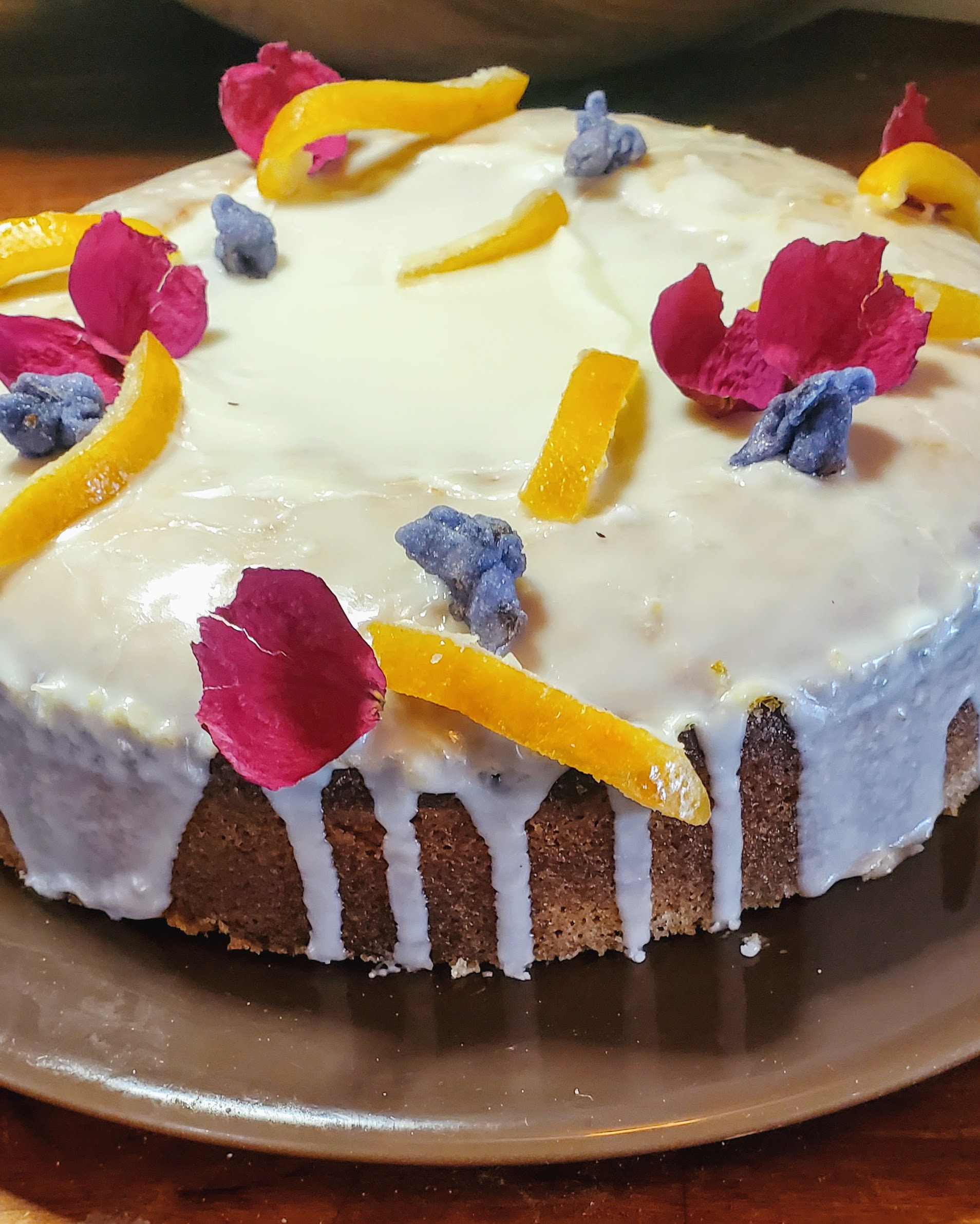
Olive Oil & Limoncello Cake
On March 22, 2022 by Christy LarsenWhen I have guests over for a meal or celebration, I am cognizant of dietary desires and restrictions. I don’t specifically design the menu around the issue, but I always make sure there are dishes served that everyone can enjoy. Dessert can be problematic, which is why I love an olive oil cake. While it doesn’t work for everyone, it is great for those with a dairy allergy. It is my go-to when I am trying to please a crowd. Best part; it can look festive and celebratory without being an elaborate layer cake. Single-layer cakes are my best friend.
Don’t let the additional components of a sop and icing deter you from trying this cake. It is a delicious addition to any celebration, or a mid-week tea and cake sesh. The addition of Limoncello (or any citrus cello) gives it a bit of an adult edge and sophistication.
for the cake:
3 extra-large eggs
1 cup + 2 Tbs granulated sugar
1 tsp kosher salt
1 Tbs lemon zest
1 1/4 cup olive oil (the less bitter, the better)
2 cups all-purpose flour; sifted
1/3 cup fine cornmeal
2 tsp baking powder
1/2 tsp baking soda
6 Tbs fresh lemon juice*
3 Tbs limoncello (or any citrus-cello)
2 tsp vanilla extract
*depending on the flavor profile you desire, you can substitute orange, grapefruit or lime (or a mixture) for the juice. Lemon packs the most punch, but you can play around. Make sure whatever you use compliments the liquor (lemon or citrus-cello).
Prepare your 9” springform cake pan by spraying with pan spray, lining the bottom with parchment, then spraying with pan spray again. Dust with granulated sugar; tapping out the excess. Preheat oven to 350.
In a stand mixer fitted with whisk attachment, beat eggs, sugar, salt, and lemon zest until they are pale yellow and reach ribbon stage (about 3-5 minutes). While whisking, slowly pour in olive oil. Whisk on medium/medium-high for another 2-3 minutes.
Meanwhile, whisk sifted flour, cornmeal, baking powder, and baking soda in a separate bowl. Measure the lemon juice, limoncello, and vanilla extract together.
With the mixer on low, alternate adding the dry ingredients (flour, cornmeal, etc) with the wet (lemon juice, limoncello, etc) beginning and ending with dry. Take care to not overmix
Pour into prepared pan and bake for approximately 50-60 minutes. It may take less, it may take more. I make a habit of checking after 45 minutes. It will brown a bit because of the sugar lining the pan; use a tester to make sure it is fully baked before removing it from the oven. The cake should be just firm to the touch.
While the cake is baking, make the sop syrup
for the sop syrup:
1/4 cup lemon juice (or other if you are changing it up)
1/2 cup granulated sugar
2 Tbs olive oil
Simmer the lemon juice and sugar over low heat until it starts to thicken to the consistency of cough syrup. Remove from heat and allow it to cool slightly. Pour 3 Tbs into a separate bowl and add the olive oil. Set aside the remaining to use in the icing. Pour the syrup/olive oil mixture evenly over the cake immediately after removing from the oven.
Make icing while the cake cools
for the icing
1 1/2-2 cups powdered sugar
1 Tbs agar-agar (optional)**
remaining sop syrup
limoncello
cream or water (if going dairy free)
**using agar-agar helps the icing firm up quicker than if you do not add it. It is an old doughnut shop trick. Be careful as sometimes it firms up so quickly that you can’t get your decorations on fast enough! Agar-agar is derived from algae and can be an allergen for some.
Stir the powdered sugar and agar-agar until fully incorporated. Add the remaining sop syrup. Use limoncello and cream (or water) to create desired consistency. Pour over slightly warm (for a less opaque glaze) or cooled (for thicker and more opaque icing) cake allowing it to over the sides. Decorate as desired.
The cake pictured is decorated with dried rose petals, candied orange peel, and candied violets.
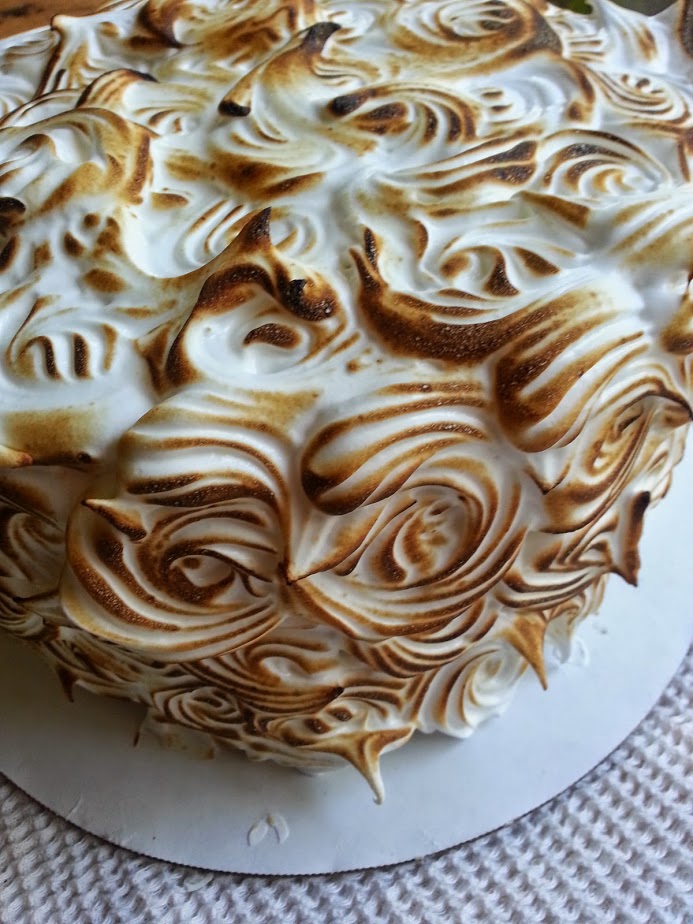
Ten Layer Lemon Meringue Cake
On April 8, 2018 by Christy LarsenLet me get something off my chest; I have a problem with layer cakes that are 3 inches of cake for every 1/4″ of icing. My ideal is {in equal measure} cake, icing, cake, icing ..and so on and so forth until you run out of both. I want layers upon layers that are none too dry or too sweet. It makes it difficult to have perfect sides, and 30 second videos of the perfect spin and frost technique. But it tastes good. Perfect is fine, but delicious is divine.
I first put together this cake for a dear friend’s 80th birthday almost a decade ago. It has become a family favorite. It is perfect all year ’round, but I like to make it when lemons are at their seasonal best.
Lemon Meringue Cake
Cake Layer
{from Nick Maglieri}
3 cups all purpose flour
3 tsp baking powder
1/4 tsp kosher salt
18 Tbs unsalted butter–softened
2 1/4 cups sugar
1 Tbs vanilla extract
9 lg egg whites
1 1/8 cups milk
reheat oven to 350. Whisk together flour, baking powder and salt in a bowl. In a mixer, fitted with paddle attachment, beat the butter and sugar until very soft and light. Whisk together the milk, egg whites and vanilla until just combined. Reduce the mixer speed to low and alternately beat in the flour and milk in 4 batches; starting and ending with flour. In order to not over-mix, do not fully incorporate each addition before adding the next one. Scrape down the sides in between each addition.
I bake this off in thin layers, making it easier to stack when putting the cake together. You can make 2 layers and slice into thin layers, if you prefer…but I like taking the time to bake off thin layers that make assembly a bit more fuss free.
This will make 6-7 thin cake layers. Each layer should be less than 1/2″ thick–i use approximately 3/4 cup batter for each layer.
Spray 9″ cake tins with pan spray and place a circle of parchment in the bottom. If you only have 2 pans, you will have to wash in between bakins. Bake each layer approximately 10 minutes, but carefully watch, as the layers are so thin, they will brown easily. Once you pull the pan from the oven, wait a few minutes, then turn out onto parchment. Wash and dry the tins, then start the process again. Let the layers cool completely. {can be made a day ahead and stored at room temperature, or well ahead and frozen}
Lemon Curd
grated zest from 1 lemon
3/4 cup lemon juice
1 1/4 cup sugar
12 Tbs unsalted butter–cut into small pieces
12 large egg yolks
Whisk the yolks, sugar, lemon juice and lemon zest in a bowl. Place bowl over bain-marie and cook, stirring continually until the liquid thickens to a nappe {coats the back of the spoon and retains shape when you swipe your finger down the middle}. Do not let it boil, as the eggs will scramble. Remove from heat and pour through a sieve into a clean bowl. Toss in the butter while the curd is still hot. Stir until the butter is fully incorporated. Cover with plastic wrap placed directly on top of the curd. Refrigerate until cool and set. {Can be made a day in advance}
Lemon Italian Buttercream Icing
{if you have a favorite icing, use it and add the lemon curd and whip until creamy}
1 cup granulated sugar
1/4 cup water
4 egg whites–room temperature
2 cups unsalted butter–room temperature
1 tsp vanilla extract
1/2 tsp salt
about 1/2 cup lemon curd {this is to taste, it depends on how lemony you want your buttercream}
Place egg whites and salt in the bowl of an electric mixer fitted with whisk attachment. Combine 3/4 cup of the granulated sugar with water in heavy saucepan and bring to a boil over medium heat. Continue cooking until it reaches 235F (just before soft ball stage).
Meanwhile, while the sugar is boiling, begin whisking the egg whites. Once, frothy, “rain” in the remaining 1/4 cup sugar. Whip to soft peak. When syrup reaches 235F remove from heat (it will continue to get hotter and reach the desired 240F). With the mixer on medium speed, begin immediately pouring the hot syrup into the egg whites. Be careful not to hit the whisk directly. Once all the syrup is incorporated, kick the speed up to high and whisk until it cools to room temperature.
Change the attachment from whisk to paddle, and begin adding butter, a few bits at a time. Once it is all incorporated and it looks like buttercream, mix in the vanilla and curd (to desired flavor)
-can be made several days in advance
Meringue
3 large egg whites–room temperature
1/4 tsp cream of tartar
3/4 cup granulated sugar
1/2 tsp vanilla
pinch salt
Make sure the beater and bowl are extremely clean and free of any oil or fats. Beat whites on low until foamy. Add salt and then kick up the speed to medium. Add cream of tartar. Beging to slowly add the sugar “raining” it into the egg whites. Continue to beat until soft peaks form, then add vanilla. Beat to stiff and firm peaks.
If you over-beat, you will see moisture starting to “weep” from the whites. If this happens, start over!
-must be used day it is made
PHEW! –now that you have all the elements, you can start building your cake
To Assemble
Place 1 cake layer on a round cake board. Pipe buttercream around the edge of the cake making a dam. Fill with lemon curd. This curd is quite tart, so you don’t want to over-do it. Also, your filling should not be thicker than your cake layers. Place another cake layer on top of the curd. Pipe a layer of buttercream. Continue with cake, buttercream dam & curd, cake, buttercream, cake….until you run out of cake layers. the top layer should be cake. Refrigerate until cold and firm. You can cover with plastic wrap and refrigerate for 24 house. When ready to finish and serve, cover in meringue (i have piped swirls), and hit with a torch to brown the edges. I do not recommend using the oven as the buttercream and curd will melt quickly.
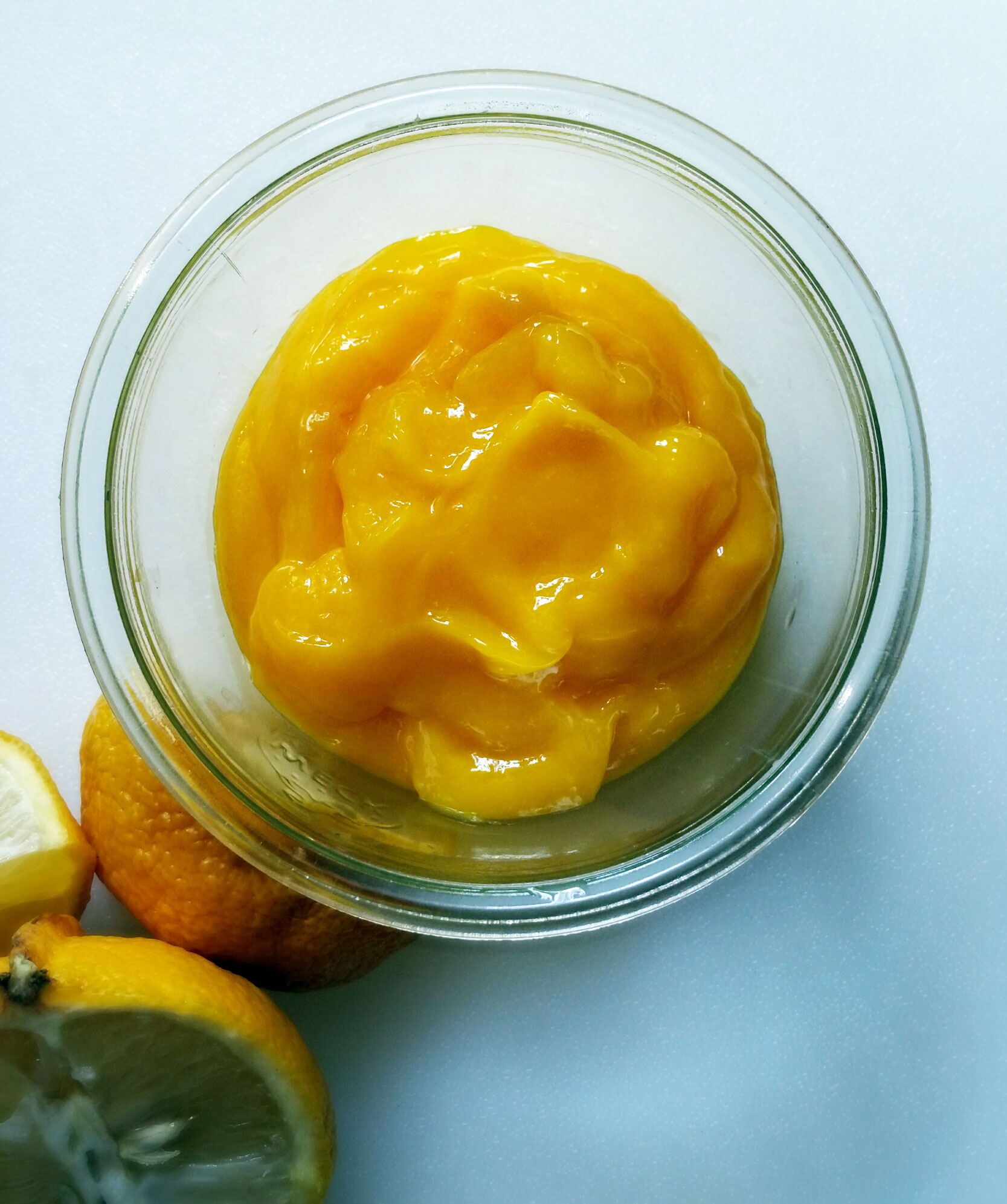
Lemon Curd
On March 30, 2015 by sixtyacrebakerI have been waxing lyrical about lemon curd for days. Finally, the desire had become so overwhelming, I took matters into my own hand. It was time. My counter top had become over-run with duck eggs, a basket of lemons was prepping for it siren song to the fruit fly migration, and I can only stand the thoughts in my head for so long. The hue of this curd is overwhelmingly beautiful and true. It is a foreshadow to the bright treat I love so much.
Lemon Curd
makes approx 3 1/2 cups
8 extra large egg yolks
1 cup granulated sugar
3/4-1 cup fresh lemon juice*
1 Tbs lemon zest
pinch kosher salt
1/2 cup unsalted butter-cut into pieces
Place the butter in a glass or ceramic bowl and set aside. Place egg yolks, sugar, lemon juice, lemon zest and salt in a med/large saucepan or high sided saute pan. Whisk to fully incorporate all ingredients. Place over low heat and stir continually with a spatula. Be mindful to scrape the sides and bottom of pan while stirring. Continue stirring until the mixture thickens enough to heavily coat the spatula, and you can easily trace a clear path through with your finger. Do not let the mixture simmer or boil, otherwise you will cook your egg yolks. Remove from heat and pour through a sieve directly into the bowl with the butter. Whisk until all of the butter is melted and incorporated into the curd. The sieve will catch any cooked particles and most of the zest. This will allow for a clear texture to your curd.
To cool, place the bowl of curd into a larger bowl of ice water (mostly ice) and stir until the temperature reduces to room temp. You may continue cooling to use immediately, or place a piece of plastic wrap directly onto the curd and allow to finish cooling in the refrigerator.
*I enjoy a very tart lemon curd as I mostly pair with sweet meringue, shortbread, or ice cream. If you like it a bit more tame, use 3/4 cup of lemon juice, if you are like me, use 1 cup.
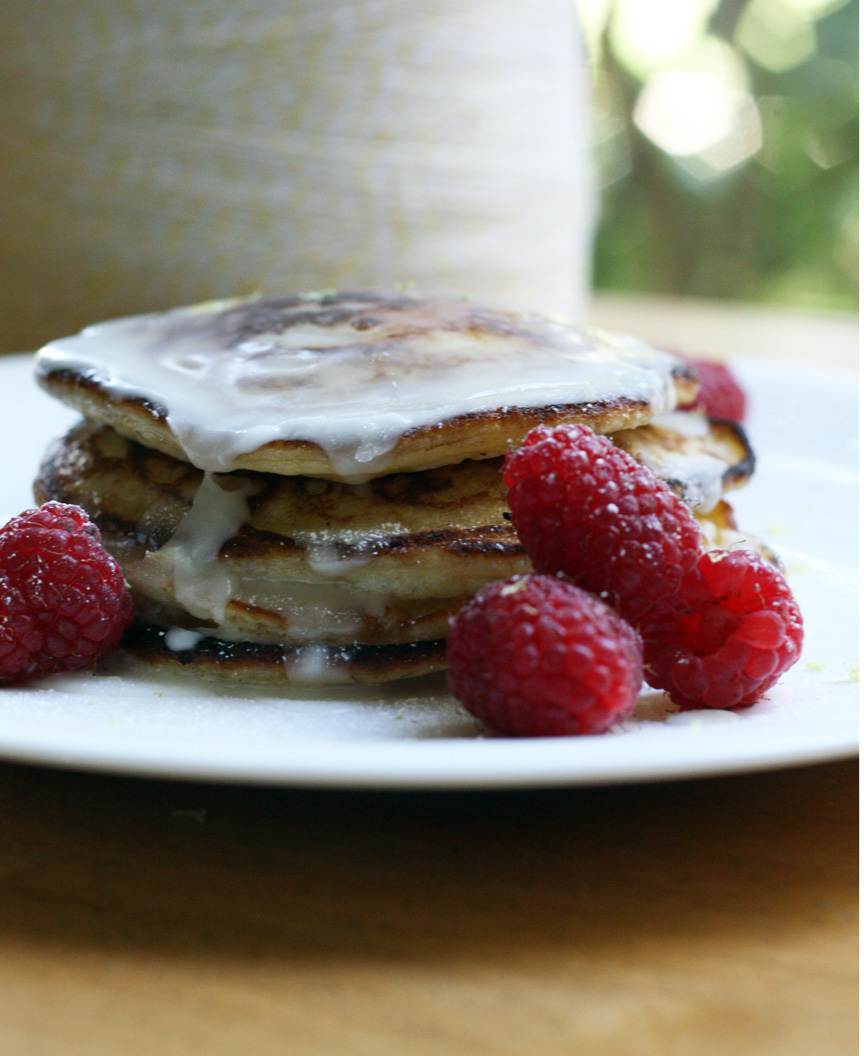
Lemon Ricotta Pancakes
On September 18, 2012 by sixtyacrebakerThe best part about these pancakes is that there is none of that pesky egg-white whipping and delicate folding. With their butter-crisp edges and billowy lemony insides, these pancake say i’m sorry and you’re welcome all at the same time.
Lemon Ricotta Pancakes
1/2 cup ricotta
1 Tbs lemon zest
2 Tbs lemon juice
2 large eggs
1 cup buttermilk
1/2 tsp kosher salt
1/2 tsp baking soda
1/2 cup fine corn meal (floury kind)
1 cup all purpose flour
6 Tbs sugar
Whisk together the flour, corn flour, sugar, salt and baking soda. In a separate bowl whisk together the ricotta, lemon zest, lemon juice, eggs and buttermilk. Stir the dry into the wet a bit at a time, to minimize lumps. Stir slowly, and just to get all the ingredients incorporated. Allow to sit about 5 minutes while you heat up the pan. I like to use butter to cook my pancakes, and i like it to get a bit brown before laying down the batter. But these pancakes are even delicious with pan spray. I suggest pureed fruit, fruit syrup or a glaze made with lemon juice and powdered sugar as a topper.
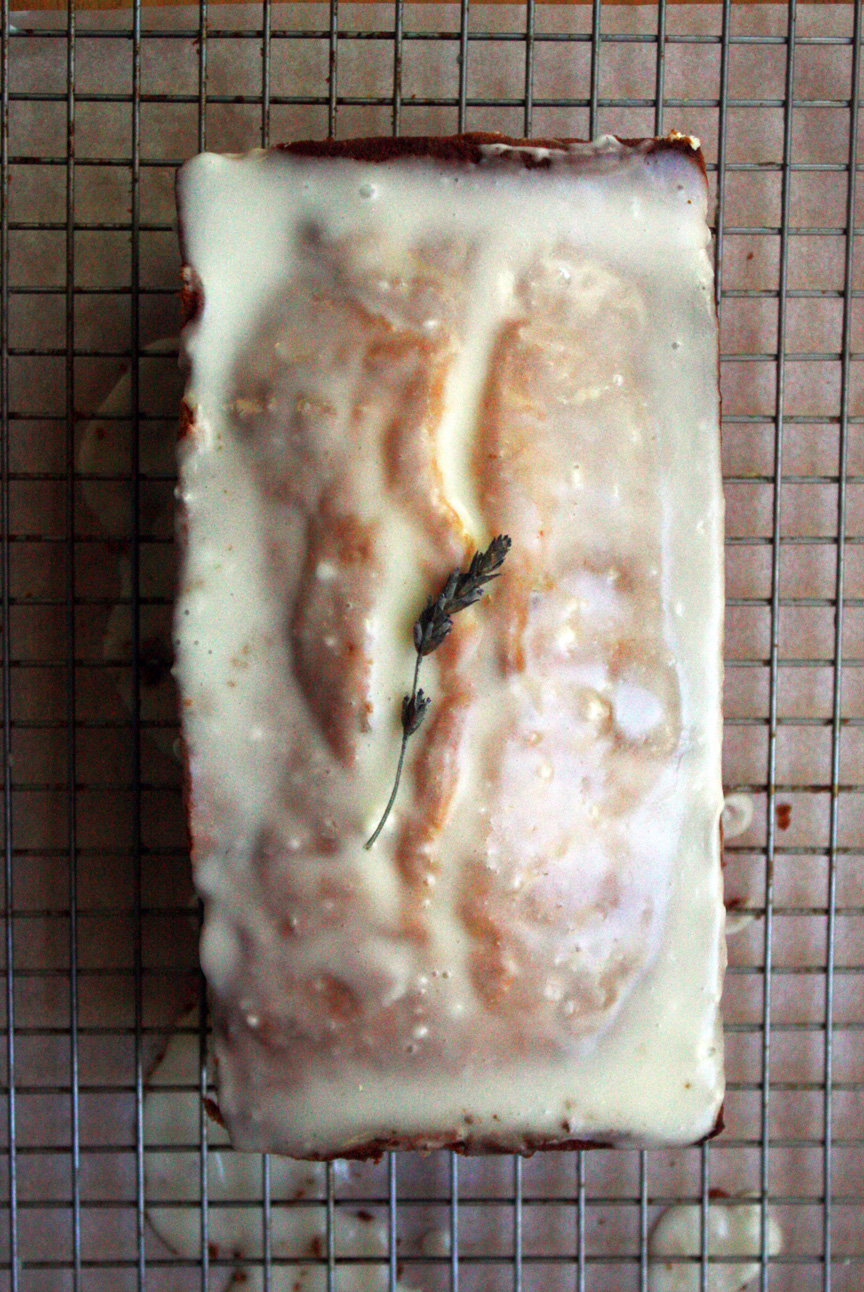
Lemon Lavender Cake
On July 20, 2012 by sixtyacrebakerI love lavender-trimming day. Delicate buds not yet spent, but given their pollen to the bees, at the ready for culinary cajoling. I bundle the limping stalks, tacking my baker’s rack with lines of purple. A scent of Provence fills the air. I toss the dried buds in everything from simple syrup to custards, aioli to bitters, shortbread to biscotti. I especially love it in this cake.
Lemon-Lavender Cake
(this is a riff on a classic 1-2-3-4 cake)
cake
1 cup unsalted butter–room temperature
2 cups sugar
3 cups flour
4 large eggs
1 cup buttermilk
½ tsp salt
½ tsp baking soda
1 Tbs lemon zest
juice of 1 large lemon
1 generous tsp dried lavender buds
Cream butter and sugar until light and fluffy. Add eggs one at a time fully incorporating after each addition. Stop and scrape down the sides with a spatula and resume beating until the mixture looks like buttercream frosting. Meanwhile…in a separate bowl, whisk together the flour, salt and baking soda. Combine the lemon zest, lemon juice and buttermilk together. With the mixer on low, alternately mix in the flour and buttermilk, beginning and ending with the flour, in 3 additions. Do not over-mix, just allow the ingredients to come together. Stir in the lavender. Pour into 2 loaf pans that have been coated in pan spray. Bake at 325 F for approximately 50 mins. Check for doneness after 40 minutes. Cake is fully baked when a toothpick inserted in the middle comes out clean.When cool, pour glaze over.
glaze
1 cup powdered sugar
1 Tbs cream
Juice of lemon (more or less to your taste)
Stir together and pour over cooled cake.
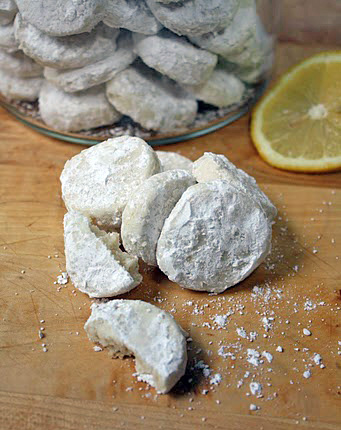
Lemon Cooler Cookies
On August 3, 2011 by sixtyacrebakerHonestly, I’m not sure if i have actually tasted the original lemon cooler cookie. I do know that I wanted to try them. But alas, they were in a box, on a shelf, in the grocery store. Lest you forgot, we have established that my mom didn’t do “store bought”. Odds are I only remember these cookies by how my friends, with better brown bag lunches than mine, described them. Which is why I believe my version is a perfect impostor. It packs a lemony punch with a sweet sugar chaser.
Lemon Coolers
1 1/2 cups unsalted butter–room temp
2 cups powdered sugar-divided
2 heaping tsp lemon zest
1/4 cup lemon juice
3 1/2 cups all purpose flour
1/4 cup cornstarch
1/2 tsp kosher salt
Stir together flour, cornstarch and salt in a bowl. In a mixer fitted with the paddle attachment, cream butter and 1 cup powdered sugar until evenly mixed. Beat in lemon zest and lemon juice. slowly stir in the flour mixture, mixing until just combined. Gather the dough and form into a flat ball. Divide dough into 4 pieces, rolling each into a log. The diameter of the log is to your own specifications, depending on your desired cookie size. My preference is about 2″ round. Wrap each log in plastic wrap and refrigerate for 2 hours or overnight. You may also freeze the log(s) at this time. When ready to bake, preheat the oven to 325. Line cookie sheets with parchment. Remove the log from plastic wrap and slice in 1/4″ rounds. Tt is helpful to twist the log clockwise each time you cut, so as to avoid a flattened bottom. Place cookies 1″ apart on the cookie sheet and bake approximately 10-12 minutes. Cookies are done when they are just turning golden on the bottom. While cookies are baking, place the remaining 1 cup powdered sugar in a shallow bowl. As you remove the cookies from the oven, they will be too delicate to handle. Once they are cooled a bit (not fully cool, still slightly warm), carefully turn them in the powdered sugar, and place back onto same cookie sheet. The sugar will melt slightly and be a bit like frosting. Once the cookies are fully cooled, toss them in the powdered sugar a second time.
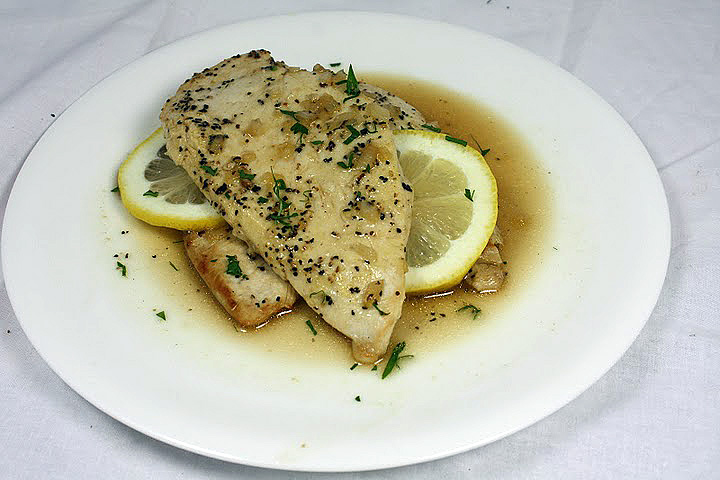
Lemon Chicken
On March 13, 2011 by sixtyacrebakerI seem to be on a bit of a citrus jag lately. I suspect the reason being this: on our back porch sits a potted lemon tree. It produces exactly 8 lemons every other year. We have coaxed coddled and crooned to it. Sadly, this is its best work. Consequently, when it produces, I get to work. This recipe is really a bit of this and smidge of that. Really delicious, very lemony and extremely popular in our house. The best part: it freezes well.
Lemon Chicken
1 lb chicken breasts
olive oil
1/2 onion–finely chopped
1/4 cup chicken broth
1/2 cup white wine
juice of 2 large lemons (a bit less if you don’t like your chicken really lemony)
1 tsp honey (or more to taste)
salt and pepper to taste
fresh parsley–minced
Pound the chicken breasts until they are thin like a cutlet. pat chicken dry. Heat enough olive oil to cover the bottom of a large skillet. Cook eat chicken breast enough to just brown, but not to cook completely through. Remove from skillet and reserve. Add a bit more olive oil and toss in the onion. Cook on medium heat until onion begins to soften. Toss in the chicken broth and use tongs or spatula to scrape up all the bits of chicken that stuck to the bottom of the pan. Add the wine, lemon juice and honey. Stir to combine, then put the chicken back into the skillet. Simmer on very low until the chicken is cooked through. Serve with the sauce spooned over the chicken. Sprinkle a bit of parsley on top. Sserve with lemon slices if desired.
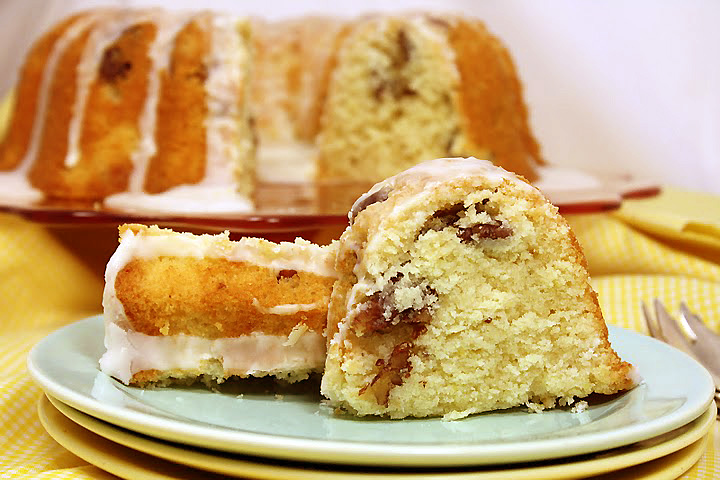
Lemon-Pecan Mascarpone Pound Cake
On March 5, 2011 by sixtyacrebakerMarch 4th is national pound cake day. Don’t roll your eyes. It is legit. I read it on the internet. Before my great aunt passed, I borrowed her box of tattered and stained recipe cards and copied each one into a book of my own. My aunt rose baked a great pound cake. Several actually. All different. All delicious. For national pound cake day, I borrowed a recipe from her, with a few substitutions.
Lemon Pecan Mascarpone Pound Cake
1 1/2 cup unsalted butter–room temp
4 oz mascarpone cheese–room temp
1/2 tsp kosher salt
1 1/2 cups sugar
4 large eggs–room temp
1 tsp vanilla
2 tsp lemon zest
1/4 cup + 1 Tbs lemon juice
2 1/4 cups flour–sifted
2 tsp baking powder
1 cup toasted pecans
Cream butter and mascarpone until very light. Gradually add sugar and beat thoroughly, about 2-3 minutes. Add eggs one at a time, scraping down sides in between additions. Beat for an additional 2-3 minutes after you add the last egg. Beat in vanilla, lemon zest, lemon juice and salt, until fully incorporated. The batter may look curdled, which is okay. Blend in the sifted dry ingredients (flour and baking powder) and mix until silky. Fold in pecans. Bake in a greased pan (10 cup capacity) at 325 for about 60 minutes. If you separate the batter into smaller pans, bake for considerably less time.
Once cool frost with icing made from powdered sugar mixed with lemon juice. Add enough lemon juice to make a drippy icing with good lemon flavor.